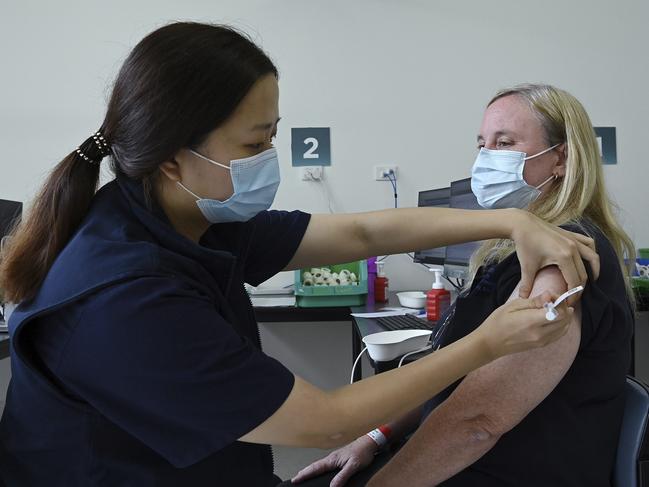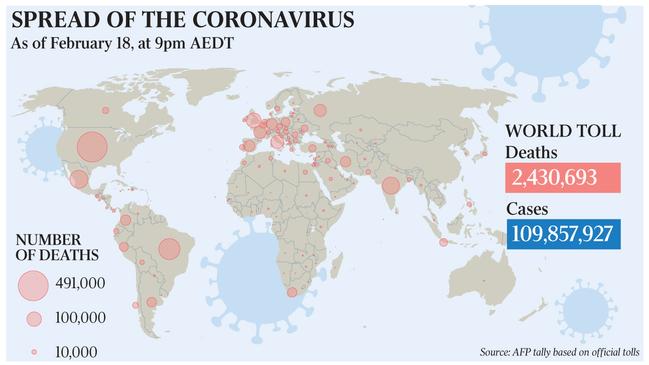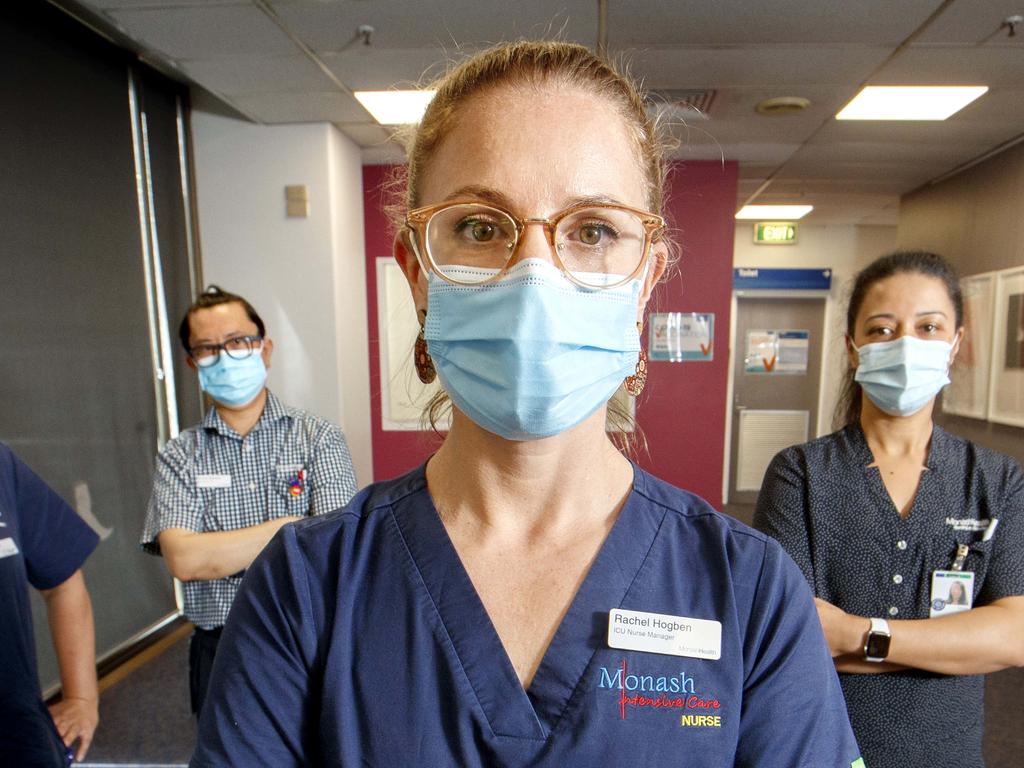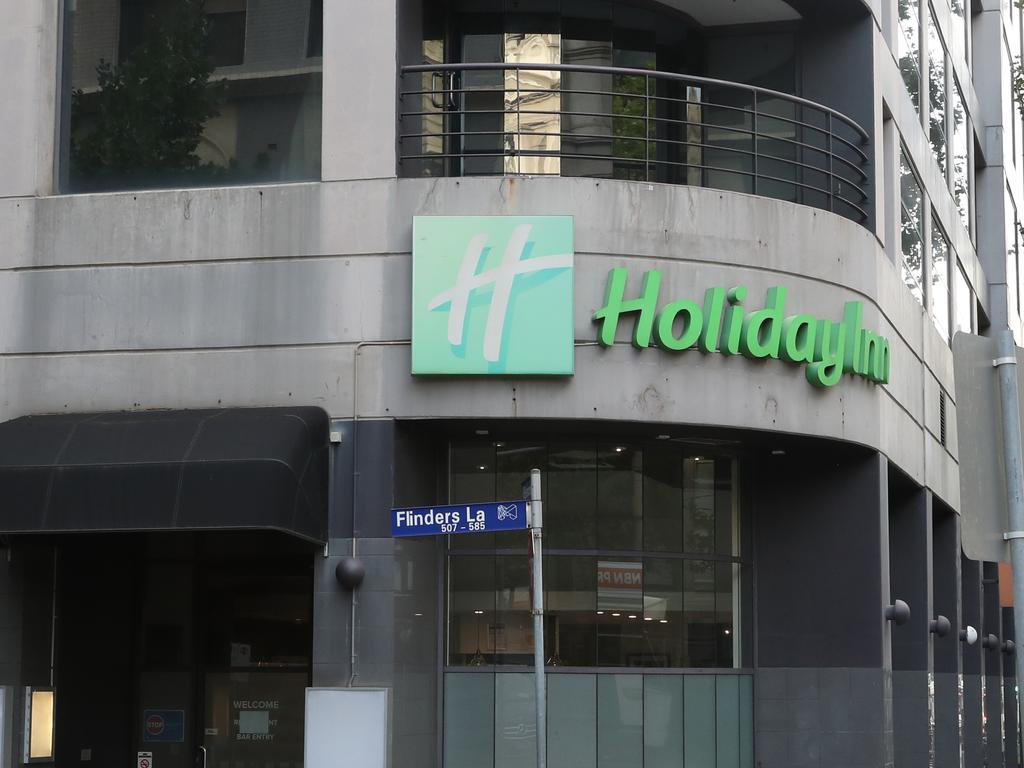Is Covid on the run at last?
The enemy may not be done with us yet, but humanity’s fightback has reached a pivot point.

Vaccinations — which began in Australia today — are the game-changer. And the world is now awash with vaccines.
“A year ago the probability of a vaccine being developed and rolled out in just a year was very low,” Health Minister Greg Hunt tells Inquirer.
Of course, we’ve thought we were winning before. There have been a lot of false dawns. It’s not Mission Accomplished just yet.
Canberra has, or has on order, more than a hundred million vaccine doses. On international evidence, vaccines work. We can look forward more realistically to recovery and some normality than at any time since the virus hit Australia in January last year.
But the virus still has time and opportunity to surprise us. It has proven itself cunning, adaptable, unpredictable and opportunistic. It could hurt us again. It’s much more mutable than we first thought. Its mutant versions — the UK, the South African and the Brazilian variants — are more infectious, probably more deadly, and have started to get together. They haven’t read the text book saying they’re finished.
Even if we win, COVID has left our world permanently changed.
Hunt tells Inquirer two mega trends that will operate this year: “One is that global cases are declining relatively quickly. The second is the increasing vaccination of Australians.”
But first, let’s just consider where we’ve been. According to the Coronavirus Worldometer, there have been 110 million infections and just on 2.5 million deaths from COVID. When deaths were at one million, the Economist magazine estimated there were at least a million more COVID deaths. Many countries have poor health systems and many COVID deaths looked like regular pneumonia. Other countries systematically lied about their death tolls. Even European countries have artificially lowered death figures. In Britain a death was only attributed to COVID if the patient died within 28 days of infection.
Some tens of thousands will be left with “long COVID”, symptoms that persist for months, perhaps years, sometimes featuring permanent organ damage.

The British economy in 2020 suffered its worst annual decline in more than 300 years, since the Great Frost of 1709. There was similar loss in the US. The economy all over the world ground to a halt in 2020. As Harvard’s Jason Furman recounts: “The synchronised shutdown in the first half of 2020 was the largest, fastest and most comprehensive reduction in economic activity ever witnessed in the modern world.”
The national death tolls are shocking. The US has more than half a million dead, Brazil a quarter of a million, Mexico nearly 200,000, Britain 120,000, Italy nearly 100,000. And, as I say, the official figures involve huge underestimates.
Health systems were overwhelmed in Italy and New York in the first wave, and nearly overwhelmed in California and Britain in the most recent wave. Some might quibble with the idea that the New York health system was overwhelmed when it chose not to use a couple of temporary, emergency facilities. But you can see that it was overwhelmed by the shocking decision of New York Governor Andrew Cuomo to send some 15,000 elderly people who had tested positive for the virus back to aged-care facilities, rather than keep them in hospitals. The aged-care facilities had no ability to isolate the positive cases or care for them properly and New York suffered a terrible death toll.
Australia has been almost unbelievably successful in controlling the virus. There were some shocking blunders made, mainly in Victoria and mainly concerning hotel quarantine, and a lack of preparedness for contact tracing and isolation in the first stages of the virus, but still it has been a magnificent national performance overall.
I disagree absolutely with those commentators who argue the nation has paid an extravagant price for a marginal benefit. Consider these two statistics. On August 5, at the height of Victoria’s second wave, the state registered 725 new infections. A couple of days earlier, on August 1, Britain registered 771 new infections.
Where would you rather have spent the next six months, and where would you have been more likely to die? Victoria experienced lockdown, inside a nation that had all but closed its international borders. Britain tried to “live with” the virus, and suffered tens of thousands more deaths, hundreds of thousands more infections, much worse economic damage and had to go into severe lockdown eventually anyway.

And this after so many commentators told us that London had achieved herd immunity, that this came at 20 per cent infection, not 70 per cent, and all the other baloney.
One of the weirdest elements has been the way some commentators have laboured so hard to see Australian success, which almost any nation in the world would love, as a sign of bad policy.
Victorian Premier Daniel Andrews deserves every criticism for his government’s repeated failures in hotel quarantine management. Some 90 per cent of Australian COVID deaths, have been in Victoria.
Our overall national death toll of just over 900 is, however, one of the world’s lowest.
Once Victoria got into its second wave, something like the long lockdown was sensible. The most recent five-day lockdown is more debatable, though you can understand the government being sensibly spooked by its own incompetence. Victorians should pray that Andrews never again assures them that anything his government is doing is “gold standard” or “world leading” or “best in nation”. Every such moment of hubris presages a new crisis. For goodness sake, stop tempting fate.
Similarly, it is not a sign that Australians don’t value their civil liberties that they tend to obey public health and safety directives (while sardonically mocking their leaders). You might as well condemn Australians as conformist because we all drive on the left side of the road, just because the government tells us to.
This virus was a unique global health catastrophe. The distinguished epidemiologist, Professor Raina MacIntyre of the University of NSW, tells Inquirer it was the distinctive combination of features that has enabled COVID to be so devastating. It’s very infectious, much more infectious than were SARS or MERS before it. It’s not as lethal as they were but it’s still very lethal, much more than the flu. It can be transmitted by someone for a long time. A key to its spread is that it can be transmitted by asymptomatic people, people who don’t know they’re unwell. And it can live in both animals and human beings
In the early phases, epidemiologists reassured us that coronaviruses are much more stable than flu viruses and don’t mutate so much. But COVID-19 is mutating powerfully. Some epidemiologists think this is a big surprise. Others say it is simply that there was so much COVID that even a low propensity for mutation gave us big changes in the virus.
Why did Australia do so well? Hunt tells Inquirer: “Our two biggest decisions were closing the border with China on 1st February, and in August deciding that we’d have a vaccine manufacturing capability at CSL.”
Producing vaccines within Australia is critical. Vaccines have played a big part in the global decline in the case rate. This has nearly halved in the past month. On January 13, the seven-day average of new daily global cases was 733,000. This week, that average has been about 380,000, still a horrendous number but heading in the right direction.
There are four main reasons for this decline: vaccinations are starting to kick in; some big population chunks have at least temporary immunity because they have had the infection; stricter lockdowns have been enforced and as death tolls have risen social distancing has become more widespread; and the seasonality of the northern hemisphere is starting to work against the virus.

Two incongruous points worth noting: in the northern hemisphere, virtually no nation has had the option of killing community transmission, as we have. That means their lockdowns had a totally different purpose from ours, just to slow the infection rate down so that the health system is not completely overwhelmed. Sweden, for a time the unwilling poster child for those who think we massively overreacted, is on the brink of a new lockdown and has had nearly 13,000 deaths. If Australia had tried more to “live with the virus” and suffered the same death rate as Sweden, by no means the worst in the developed world, that would be 30,000 dead Australians by now.
The other incongruous note is we don’t quite fully know why the virus retreats in the northern hemisphere in February. It’s still pretty cold in February. But in reality the virus has tricks we don’t yet completely understand.
Nonetheless, global science has had a magnificent victory on vaccines. The Australian government has also had a singular success.
Hunt was almost perfectly designed to be Health Minister in this crisis. He is a natural political and policy obsessive, somewhat like Josh Frydenberg, one of that species of 24/7 political and policy activist. He looks for the big picture but many big-picture politicians trip up because they don’t understand the detail. The big picture makes most sense when you also know a lot of detail. Hunt thirsts for detail. The decision to manufacture vaccines in Australia is a sign of our new post-COVID world. It breaches every tenet of market economics. It’s cheaper and more efficient, more economically rational, to make vaccines in giant facilities in giant economies.
But COVID has taught us that we need to secure critical supply chains. Morrison and Hunt offered CSL a 15-year contract for vaccines, which made it worthwhile for CSL to invest in new vaccine manufacturing capability.
The government now has, or has on order, more than 100 million vaccine doses across three different vaccine types. It has 20 million Pfizer vaccines. This is an mRNA technology that has never existed before. It instructs our body’s cells on how to make a bit of protein, which triggers a powerful immune response. This is an epic scientific breakthrough and will be a technology of the future. It is believed CSL is looking at acquiring an mRNA capability in due course.
Meanwhile, CSL will make 50 million doses of the AstraZeneca vaccine. This uses viral vector technology. It gives our bodies a different virus, which doesn’t hurt us, but which teaches our cells to make a bit of the deadly virus, which then triggers our immune response.
The government will also acquire 50 million-odd Novavax doses. This is an old-fashioned protein vaccine that gives us a weak bit of the disease we’re fighting to directly trigger the immune response. Finally, the government has a substantial entitlement of the Covax facility, which brings together a lot of different vaccines.
All these vaccines, as Health Department head Brendan Murphy outlined this week, seem at this stage totally effective at stopping death and serious disease, although their efficacy against mild disease might vary a bit.
All of that is as good an outlook as the world, and Australia, have had in a long time. But as Professor Jodie McVernon of the Doherty Institute tells Inquirer, we can expect more zoonotic (animal-to-human) pandemics in the future.
And this virus hasn’t quite finished with us yet. It will take months to vaccinate Australia and years to vaccinate the world. The next pandemic could just as easily be more deadly and more transmissible. A new mutation of COVID-19 could find a way to attack children, or overcome vaccines. And none of this is even to contemplate what malicious militaries and biological weapons programs may have learnt about the potential to weaponise this knowledge.
But for now, let’s remark with some gratitude our inestimable good fortune at being Australians, and celebrate, even provisionally and with one eye over our collective shoulder, this singular national success.





At last, and for the first time, the enemy might be at a permanent, structural disadvantage. Humanity’s fightback against COVID-19 is now at a pivot point. We just might have the bugger on the run.